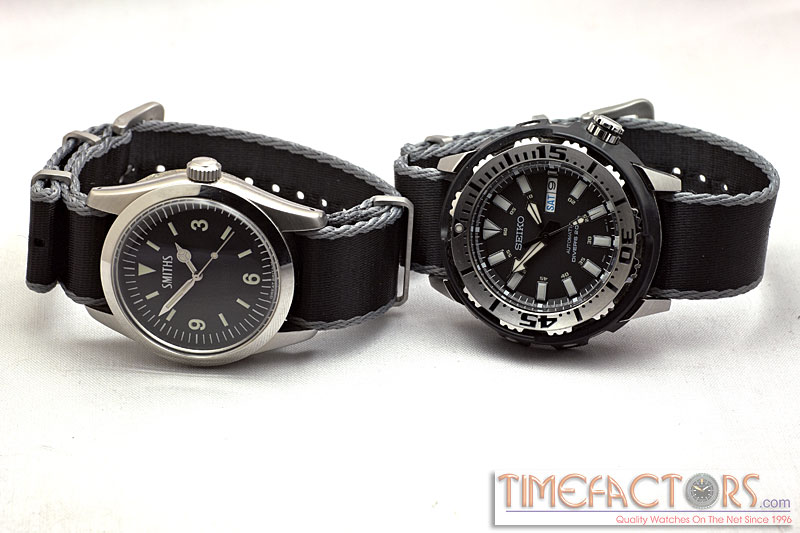This week I’m asking you to bear with me for a moment, because on first impressions our subject may appear a bit less glamorous than usual.
It’s not though, I promise. It’s fun and adds pleasure and value to your collection for relatively little money. Trust me, I have your best interests at heart.
Straps – once just things which came with your watch, now an entire industry of its own producing a kaleidoscope of options. Canvas, Kevlar, tweed, NATO, a hundred different types of leather, Nylon, rubber, suede, plastic, waxed cotton, thin, thick, colourful, plain – there are suddenly a thousand choices out there.
I think that if you don’t have a few spare straps beside your watch box you’re missing out on one of the great joys of this relatively recent trend: namely that changing a watch’s strap completely changes how that watch looks and feels. It’s akin to having a new piece at a fraction of the price and just as you’re becoming a little too familiar with the watch you’re wearing a new strap gives it a whole new lease of life.
It’s also no coincidence that sellers of used and vintage watches often go out of their way to put the right strap on them first, and for good reason. That Seiko Bullhead at £500 might not differ much from the other eight for sale on eBay, but on a distressed Horween brown leather strap with tan stitching it looks so much better than the competition.

Distressed leather from Jose Aguilar at CB Straps.
I’m going to introduce you, in a moment, to a few strap makers from whom you can buy glorious things in a variety of price brackets but first let’s have a lightning tour of your options, what’s classic and what’s new.
Back in the day, pre-war, watches came almost exclusively on leather straps, and that was really your lot. The odd ladies’ dress watch might have come on a gold bracelet but it was really a piece of jewellery with a watch in it, rather than a strap. Then as men’s watches grew a little larger and their robustness became a selling point, many makers began to offer bracelets until those finally became the norm for tool watches (dress watches, obviously, belong on leather straps to this day).
In the 1960s, with the growth in popularity of the dive watch, we began to see rubber straps offered by some manufacturers (either because they were essential if you were actually going to use the thing for its intended purpose or because it looked ‘authentic’). My early Panerai comes with both brown leather and black rubber strap options in the box and that’s quite normal these days.
Really that’s how things stayed, at least in the mainstream, for about 40 years – leather, bracelet and rubber. Moreover, these tended also to be the classic two-piece strap which had ruled the roost for ever too; and then came the NATO, and the game changed.

Deluxe NATO straps from Timefactors.
Today the strap design created to ensure military watches would stay on the wrist come what may is everywhere. In essence the NATO differs from a traditional strap in two ways: first it is a lengthy single piece running through both lugs, rather than two smaller pieces, which reduces the chances of mishap. Secondly the way it is secured to the watch and the wrist means it has in-built redundancy – if one part breaks or tears the watch should remain held on by the other.
The trend for off-duty British soldiers to wear their watch on a NATO strap in the stripes of their regimental colours, which began in earnest in the 80s, caught the wider imagination and today a stroll through the business district of any major city will see chaps unknowingly wandering about bearing the colours of some of the British army’s great regimental names on their wrists.
And all of this came about as the way mechanical watches were bought was changing. As they became luxury items rather than the best timekeeping devices you could buy, it became more acceptable to think about how they looked as well as how they worked.
The last five years has seen another period of acceleration in the number of options available. New materials, more daring thinking, much more fun being injected in to what was previously a very practical thing to buy.
As an example one need look no further than British watch brand Schofield, whose pieces we’ve discussed in this column before.
Giles Ellis’s company is overtly as much about the aesthetic as it is the technical, and the range of Schofield straps reflects this.
Tweed may not immediately seem like the best material for a watch strap but Schofield have shown the benefits of thinking out of the box. Its tweed straps are robust, flexible and wear wonderfully, in both senses of the word, feeling lovely but also attaining their own unique patina over time. They also come in a variety of great colours which set off almost anything perfectly, as this blue number demonstrates rather well.

At £168 in the UK they are not cheap, but then they are not cheaply made, being produced by the Moon Mills weaving company in West Yorkshire and lined with the same material Schofield uses for its watch wallets. The range is here.
At the other end of the financial scale is Jose Aguilar in Cadiz, a one man band working alone in his own workshop producing pieces to order mainly in leather but occasionally in canvas too.
Like may solo operators, you’ll find the ordering process somewhat scattergun and Jose has a tendency to drop off the radar (he’s making straps not answering emails), but when your package arrives you’ll be blown away by the quality and attention to detail and you’ll only have spent around 50 Euros, which is ridiculously cheap. As they’re hand-made, they’re also all slightly different. Jose’s website is here.
A great, simple place to start your strap collection is the online shops attached to watch websites like Hodinkee and Worn&Wound, both of which carry a wide, affordable range. I particularly like Hodinkee’s suede straps at $149-$170.
Hodinkee even has an online “strap-finder” which allows you to find your watch, or one very like it, and see how it looks with a variety of options. It’s dangerously addictive, I warn you.
Finally, let’s deal with NATO straps. These can be found these days in numerous materials but given the way they wear I tend to think they can easily become too bulky on the wrist in anything much other than Nylon. Of course the real “G10” and “RAF” pattern straps are made from Nylon because it’s tough, so not only are these the best to wear, they’re also the most effective and authentic.
The downside of the growth in popularity of these things is there’s endless rubbish out there.
Luckily, about the best you can buy will still only cost you £12 in the UK if you know where to look, and now you do.
Timefactors is something of an institution in watch world. A couple of years ago, tired of seeing rubbish, boss Eddie Platts decided to offer a better NATO strap in both 20mm and 22mm.
His versions are made from slightly thicker Nylon, but are a little more supple than cheaper ones as well as stronger (not least because the stitch count is double that you’ll usually find). They come in a variety of colours/patterns and there’s also a two-piece version.
You can easily pay three or four times as much for a NATO which is nowhere near as good. Eddie’s straps are here.
These are just a small selection of what’s out there. I haven’t even touched on Bremont’s lovely Kevlar/leather offerings, or some of the very top end hand-made leather options available.
But if you want to add new life to your watch collection, and have some fun doing it, buying a strap tool and adding a few options opens a whole new chapter in your enjoyment of your watches.
Go to it and enjoy.


